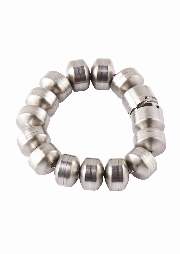In February, Building Better Healthcare reported the launch of a revolutionary new treatment option for sufferers of gastro-oesophageal reflux disease (GORD). The LINX Reflux Management System is a small flexible band of titanium beads with magnetic cores that helps to create a barrier to the reflux of acid and bile from the stomach. Here, BBH editor, JO MAKOSINSKI, speaks to one of the UK surgeons who has embraced the device and a patient who has seen their life transformed, as NHS trusts across the country consider whether or not to offer the solution to tens of thousands of sufferers
“Traditionally, treatment options for GORD have been very much an all-or-nothing approach and often, while they might stop the reflux, the side effects can be just as disabling.”
For clinicians like Ken Park, a general and gastrointestinal surgeon from Aberdeen, it is this dilemma that prevents patients from getting true relief from a condition that can have a massively detrimental effect on their lives.
He told BBH : “It is estimated that a fifth of adults will consult their doctor at some time for problematic reflux. For the vast majority of people it is something that passes and they recognise what they have done and can avoid the things that trigger it. But, for a proportion of patients, it is something they suffer from regularly and it interferes with their lives and becomes a disease and a disability.
“While most of these patients will be prescribed medication to reduce the amount of acid their stomach produces, it is not really getting to the root of the problem, which is a physical condition where the valve between the oesophagus and the stomach is incompetent and does not close properly between meals.”
Traditionally, treatment options for GORD have been very much an all-or-nothing approach and often, while they might stop the reflux, the side effects can be just as disabling
As well as the medical approach using proton pump inhibitors such as omeprazole, lansoprazole and pantoprazole, doctors have, since the 1950s, been offering a surgical procedure to tighten the junction between the stomach and the oesophegus, known as fundoplication. This involves gathering the part of the stomach that is closest to the entry of the oesophagus and wrapping and suturing it around the lower end of the oesophagus and the lower oesophageal sphincter. This increases the pressure at the lower end of the oesophagus and thereby reduces acid reflux.
When the surgery was first carried out in the 1950s, it was through open surgery accessed via the abdomen, but by the 1980s it was being done via a minimally-invasive, or keyhole, approach, making it much more widely accessible.
Park explained: “In the 1960s and 1970s the choices were medical management or a fairly big operation, so only people with really bad reflux had treatment. They would be those who were severely disabled with it or had bad complications with medical therapies. When it became more accessible and people were only in hospital for a couple of days and went away with just a few small incisions, a lot more people started to enquire about it and wanted something done about it rather than taking medicines for the rest of their lives.”
The popularity of fundoplication was further impacted by changes to the medical system in continental Europe and in particular Belgium, where patients were prescribed drugs for a three-month period, but if they needed them any longer they had to foot the bill themselves. This put pressure on surgical services and laparoscopic techniques became more and more advanced.
However, despite making the surgery becoming less invasive, fundoplication does not offer a complete solution.
Park said: “The problem is that, while it stops reflux, it has quite significant side effects. Everyone seems to have a bit of difficulty swallowing afterwards and because it creates such an effective valve, patients cannot vomit or burp. This is quite a big problem as it can be distressing and can cause a feeling of discomfort and bloating. In addition, the vagus nerve, which extends from the brain to the abdomen, can be damaged, either by scar tissue or by the surgery itself.”

The Linx system involves a band of magnetic interlinked titanium beads which allow drink and food to pass through normally, but close immediately after swallowing to restore the bodys natural barrier to the reflux of acid and bile
The vagus nerve is crucial for controlling muscle movement, keeping a person breathing, and for transmitting a variety of chemicals through the body. It also contracts the muscles of the stomach and intestines to help process food and send back information about what is being digested and what the body is getting out of it.
Park said: “A lot of people who have fundoplication come back saying it has cured the reflux, but they are just as disabled by the side effects. It is a difficult judgement call when you do something for a lifestyle reason, if you risk creating defects that are just as bad.”
Until now, there has been no other option and the hundreds of thousands of sufferers have had to take medication, often for their entire lives, or take on the risks that fundoplication involves.
Now there is a third option – the LINX Reflux Management System from Torax Medical. Fully reversible and implanted through a keyhole procedure, the solution involves the insertion of a small, flexible band of interlinked titanium beads with magnetic cores that helps to create a barrier to the reflux of acid and bile.
The LINX implant made a massive difference from the word go. I can now go out for a meal or to someone’s house, which I could never do before as I would be in so much pain, I would have to go home early
When swallowing, the magnetic bond holding the beads closed is broken, allowing drink and food to pass through normally. The magnets then close immediately after swallowing to restore the body’s natural barrier to the reflux of acid and bile.
The band is placed around the oesophagus just above the stomach during a minimally-invasive procedure lasting just an hour. It works straight away and patients can resume a normal diet within a few hours and return to normal activities in less than a week. Unlike fundoplication, the system also allows belching and vomiting.
In clinical trials it was found to significantly reduce levels of acid exposure in the oesophagus for two years after implantation. In addition, 86% of patients completely stopped taking medication following insertion, and 90% had a normal level of acid exposure in the oesophagus. It has since been implanted into 17 UK patients.
The system has not yet been adopted by the NHS for widespread public use, but is being offered at a number of private hospitals.
Park said: “I first saw this being demonstrated at a seminar and it is not often you go to these meetings and come away feeling you have found something really great.
“LINX is a much more physiological solution, designed to work like the body would naturally. It is giving a degree of resistance, but enables belching and vomiting, which is really important. It is much more like a normal valve rather than the superefficient valve you get with fundoplication.”
While he said it would not be ideal for someone with the severest types of reflux, for the majority of patients it could prove a life-changing decision.
“Before we had a bit of an all-or-nothing approach to GORD,” said Park. “The trouble is that a lot of people come in between. They are not willing to undergo an operation that will give them other problems, but if you ask them if they are happy to continue as they are they would say ‘no’. LINX provides something to fill that gap and I am convinced it is a big advantage. I have already put in three and am doing a fourth in May. Potentially it could be a solution for tens of thousands of patients.”

Jacqueline Thomson says having the Linx implant has changed her life
One of the patients to have benefited is Jacqueline Thomson, who had the LINX device implanted in November 2011. She said: “I had suffered from acid reflux for five or six years and was being given tablets, but had a lot of side effects and I was getting chest pains and could not breathe properly. It got to the stage where the reflux was that bad there was no more tablets they could give me. I was being sick in the evenings and even a drink of water would give me heartburn.”
After having the implant fitted, she was discharged from hospital the following day and the swelling and slight discomfort she felt afterwards was gone in a few weeks.
She said: “The LINX implant made a massive difference from the word go. I can now go out for a meal or to someone’s house, which I could never do before as I would be in so much pain, I would have to go home early.
“I have taken all different remedies in the past, but now I can drink and eat most things. Before the LINX system, I was always bloated and felt I looked six months pregnant and that has all gone down too. I would definitely recommend it and am really glad I had it done. I don’t even know it’s there and now I feel I can live my life again.”




